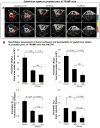Inositol hexaphosphate inhibits tumor growth, vascularity, and metabolism in TRAMP mice: a multiparametric magnetic resonance study
- PMID: 23213071
- PMCID: PMC3662486
- DOI: 10.1158/1940-6207.CAPR-12-0387
Inositol hexaphosphate inhibits tumor growth, vascularity, and metabolism in TRAMP mice: a multiparametric magnetic resonance study
Abstract
Herein, employing anatomical and dynamic contrast-enhanced (DCE) magnetic resonance imaging (MRI), we evaluated noninvasively, the in vivo, chemopreventive efficacy of inositol hexaphosphate (IP6), a major constituent of high-fiber diets, against prostate tumor growth and progression in transgenic adenocarcinoma of the mouse prostate (TRAMP) model. Male TRAMP mice, beginning at 4 weeks of age, were fed with 1%, 2%, or 4% (w/v) IP6 in drinking water or only drinking water till 28 weeks of age and monitored using MRI over the course of study. Longitudinal assessment of prostate volumes by conventional MRI and tumor vascularity by gadolinium-based DCE-MRI showed a profound reduction in tumor size, partly due to antiangiogenic effects by IP6 treatment. As potential mechanisms of IP6 efficacy, decrease in the expression of glucose transporter GLUT-4 protein together with an increase in levels of phospho-AMP-activated kinase (AMPK(Th172)) were observed in prostate tissues of mice from IP6 fed-groups, suggesting that IP6 is interfering with the metabolic events occurring in TRAMP prostate. Investigative metabolomics study using quantitative high-resolution (1)H-NMR on prostate tissue extracts showed that IP6 significantly decreased glucose metabolism and membrane phospholipid synthesis, in addition to causing an increase in myoinositol levels in the prostate. Together, these findings show that oral IP6 supplement blocks growth and angiogenesis of prostate cancer in the TRAMP model in conjunction with metabolic events involved in tumor sustenance. This results in energy deprivation within the tumor, suggesting a practical and translational potential of IP6 treatment in suppressing growth and progression of prostate cancer in humans.
©2012 AACR.
Conflict of interest statement
Figures





References
-
- Gronberg H. Prostate cancer epidemiology. Lancet. 2003;361:859–64. - PubMed
-
- Ko YJ, Bubley GJ. Prostate cancer in the older man. Oncology (Williston Park) 2001;15:1113–31. - PubMed
-
- Bhatt RS, Bubley GJ. The challenge of herbal therapies for prostate cancer. Clin Cancer Res. 2008;14:7581–2. - PubMed
-
- Brand TC, Canby-Hagino ED, Pratap Kumar A, Ghosh R, Leach RJ, Thompson IM. Chemoprevention of prostate cancer. Hematol Oncol Clin North Am. 2006;20:831–43. - PubMed
-
- Singh RP, Agarwal R. Prostate cancer and inositol hexaphosphate: efficacy and mechanisms. Anticancer Res. 2005;25:2891–903. - PubMed
Publication types
MeSH terms
Substances
Grants and funding
LinkOut - more resources
Full Text Sources
Medical
Research Materials

